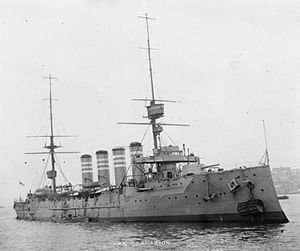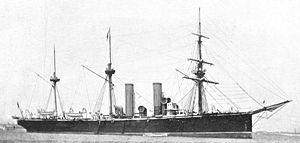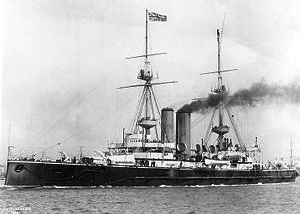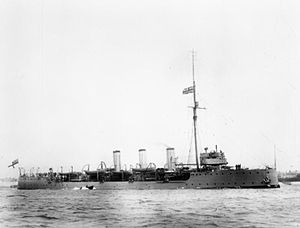Leading Stoker Frank Sidney Price
S.S. 102303 Royal Navy
Frank was born on 9th July 1883 at Radcliffe, Nottingham and was brought up by his grandparents William Price, a jobbing gardener and Rebecca Price, a dressmaker. On the 1901 census Frank, aged 18, was living with them at Bailey Lane, Radcliffe on Trent and was a grocer’s assistant.
On 19th January 1906 Frank joined the Royal Navy signing up for 5 years regular service plus 7 years in the reserves. His civilian occupation was noted as a groom and he is described as 5ft 5 inches tall, with dark brown hair, blue eyes and a fresh complexion. After a period of training at HMS Vivid, the Royal Naval barracks at Devonport, Frank served on the HMS Carnarvon, a Devonshire-class armoured cruiser first launched in 1903. It was part of the Mediterranean Fleet, with a complement of 655 officers and men and a 10,850 ton displacement.
In July 1907 until February 1910 he served aboard HMS Leander, an obsolete cruiser which had been re-fitted as a depot ship for torpedo boat destroyers, serving in the Mediterranean with a complement of 275 and displacement of 4,300 tons.
He also served on the HMS King Alfred, a Drake-class armoured cruiser, which collided with the steamship ‘Cheapside’ at Start Point in 1910 and was in for repairs for three weeks as a result. In 1911 after serving his five years, Frank was transferred to the Royal Fleet Reserve.
In July 1914 Frank either re-joined or was called up from the reserve in his pre-war rank as Stoker I (First Class) and after just a few weeks at a land base he saw active service on HMS Vengeance in August 1914 until 29th July 1915. On 3rd November 1914 Churchill ordered the first British attack on the Dardanelles (before war had been formally declared on the Ottoman (Turkish) Empire). The mission was to test the Ottoman defences. The attack led the Ottomans to strengthen their defences by laying some 570 mines in the Dardanelles Straits. By 19th February 1915, the ‘Battle of the Dardanelles’ had begun, a ten month battle of attrition. On 18th March 1915, 12 British and French battleships plus 4 supporting ships and 2 reserve ships were arranged in three lines. Vengeance was in the third line with Irresistible, Albion and Ocean. Vengeance and Albion were unharmed but Ocean struck a mine, which jammed its steering gear and Irresistible hit a mine and started drifting helplessly. The French battleship Bouvet in the second line also hit a mine and sank in minutes with a loss of 639 lives. After the battle, a rescue operation was mounted for the listing ships but they had disappeared and sunk without a trace. Gaulois, Suffren and Inflexible were all severely damaged. In total the British and French suffered 700 casualties. A controversial battle in its day as old, ill equipped battleships were deliberately sent to test the Ottoman’s defences, as the ships were considered expendable. Frank was very fortunate that the Vengeance was spared. It was a terrifying task to be a stoker in a battle situation, especially aboard an old ship, deep down in engine rooms, probably coal driven, shovelling coal in 150 degrees, or tending oil fired engines, with the hatches fastened down and the possibility of being wiped out in seconds by a direct hit on the hull. There would be no visible signs to warn of an impending hit.
In late July 1915 Frank served on the HMS Jupiter, a Majestic-class pre-Dreadnought battleship launched in 1895. (In February 1915, when on ice breaking duties, she had made history as the first ship to get through ice to Arkhangelsk and her February arrival there was the earliest in history.) In July 1915 Frank was promoted to Acting Leading Stoker and set sail in August 1915 aboard the Jupiter which was on Suez Canal patrol. In October 1915 Jupiter was transferred to the Red Sea to become guard ship at Aden and flagship for the Red Sea Patrol. Frank was made up to Leading Stoker in November 1915. Jupiter was then sent back on Suez Patrol until late 1916. During that time her home port was Port Said, Egypt. Frank returned to shore base Vivid II in December 1916 and remained stationed at Devonport until 14th April 1918.
In the early Summer of 1917, Frank married Ada Warren, a domestic servant born at Westwood, Notts in 1892 and in 1917 they had a daughter named Hilda Elizabeth who was christened at St. Mary’s, Westwood, father’s occupation given as a sailor.
On 15th April 1918 Frank was assigned to HMS Foresight a light scout cruiser with a complement of 298 men and a displacement of 2,860 tons. Frank was heading right back to the Dardanelles but this time aboard the Foresight, appointed the Commander in Chief’s Mediterranean flagship. On the last day of October 1918 Turkey had gone out of the war and signed the armistice. From the 1st to the 8th of November seven minesweepers were despatched to the Dardanelles to sweep up mines en route to Constantinople. On 12th November at 3.30am a fleet of allied ships, set sail up the Dardanelles in the following order:- British destroyers, British light cruisers (the flagship Foresight included), British battleships, French ships, Italian ships and Greek ships. All navigation lights were burned, for the first time since hostilities had begun and paravanes, a torpedo-shaped device towed from the bow of a vessel so that the cables would cut the anchors of any moored mines, were ‘streamed’. Passing through the entrance, HMS River Clyde, beached there in 1915 could be seen. An eye witness account by S.E. Brooks recounts, “One was struck by the formidable appearance of both coasts which were literally a complete line of natural defences, forts of huge structure, guns of large calibre and innumerable earthworks, in brief an elongated Gibraltar. On either side thousands of Indian troops lined the forts and were silhouetted in places against the sky, truly an imposing spectacle. At 2.10pm the bottom of the French battleship ‘Bouvet’ and our own submarine ‘E15’ were sighted, the former sank on 15th March 1915. At 7am on Thursday 13th November the picturesque minarets of the capital were first sighted and shortly after 8am the British battleships and light cruisers were anchored, followed by intervals by the large Allied ships berthing. A patrol of destroyers maintained an anti-submarine lookout to the westward of the fleet at anchor. On both European and Asiatic sides, great displays of Allied flags were visible and cheers could be heard from all directions.”
No doubt, in some ways, another terrifying experience for Frank, sailing through previously heavily mined waters to claim Constantinople, but gratifying also to return, three years later, to the very place where he had witnessed the loss of three battleships and 700 lives.
In late 1918 the Foresight was in Russian waters and on 24th December 1918 set sail from Yalta for France with Grand Duke Alexander Mikhailovich, a surviving member of the Romanov Russian royal family and cousin to the Emperor, on board. Mikhailovich attended the Paris Peace Conference as representative of the Romanov family.
By 11th February 1919, Frank was back at Vivid, the naval shore base and was demobbed in May 1919. As he is named on the Jacksdale war memorial as having served, he must have returned home to Westwood and in 1921 Frank and Ada had a son named Jack, by which time they had moved to the Nottingham district.
A death is recorded in the Nottingham district in 1939 for a Frank S. Price aged 57 years.













